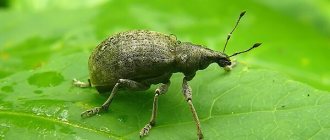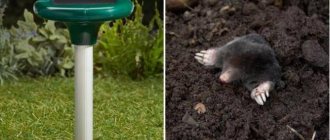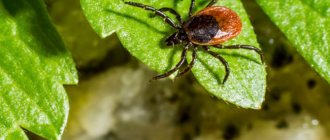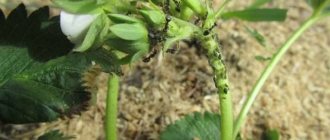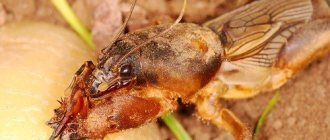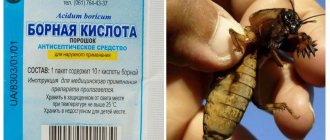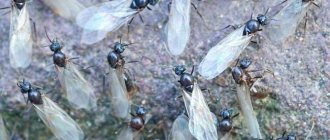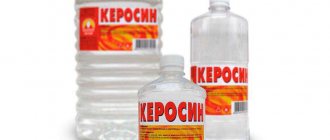Home / Pests and diseases
Back
Published: 07/23/2019
0
Rate this post
An insidious and voracious pest is a real disaster for the garden, so if traces of the presence of this insect are detected, it is necessary to quickly begin the fight. Many summer residents, doing without toxic “chemicals”, successfully use ammonia for mole crickets.
Of course, it is better if the cabbage weed (crayfish, topping) does not appear on the site at all, but if the “enemy” has already arrived, you must fight correctly and until victory.
- 1 Description of the drug and its effect
- 2 Methods for using ammonia on the site 2.1 Watering seedlings
- 2.2 Watering adult plants
- 2.3 Ammonia and shreds
Why you need to destroy mole crickets in the garden
The insect usually severely damages the root system of plants, as well as their entire underground part, including the root collar, tubers and even recently sown seeds. It not only eats them, but also digs wide passages underground, preventing them from germinating. The mole cricket attacks seedlings of berry and ornamental crops both in greenhouses and in open ground, and in gardens. Most often the pest affects:
- sugar and fodder beets;
- White cabbage;
- bell pepper;
- radish;
- poppy;
- potato;
- carrot;
- tomatoes;
- beans;
- cucumbers;
- pumpkin.
The most effective means of combating mole crickets
Mole cricket is especially dangerous for young cabbage. It is even popularly known as “kapusyanka”. The insect also attacks melons (melons, watermelons), as well as grains. A delicacy for mole crickets are young stems of hemp, sunflower and tobacco. In the southern regions of the country, it damages peanuts, citrus fruits and tea. The pest reproduces at an amazing speed: in one season, the female is capable of laying up to 400 eggs.
Brief description and signs of appearance
The insect is easily recognized by the presence of strong claws, short hard elytra and an elongated body 5-6 cm long. The habitat of the mole cricket is the ground, where it makes passages and lays offspring. In one clutch, the female produces from 100 to 500 eggs. After 3 weeks they degenerate into full-fledged insects. The damage caused by the mole cricket is enormous: it eats literally everything that gets in its way: root vegetables, seeds, seedlings.
The pest normally survives frosts, is not afraid of temperatures dropping below 0, and when the weather gets warmer it goes hunting. The period of activation of parasites begins in mid-spring, as soon as the soil warms up above 12 degrees. You can recognize that a mole cricket is attacking crops in the garden by several signs:
- horizontal passages appear located near the plants. They are especially noticeable on wet ground;
- young shoots suddenly dry out;
- lesions resembling bites appear on the tubers;
- holes are formed in the soil - burrows.
Since the mole cricket is a large insect, it is not difficult to spot. Often it appears on its own near the beds, especially if there are already many colonies. As soon as the pest is noticed, it is necessary to quickly take measures to destroy it.
Properties of ammonia
Ammonia is a colorless gas with a strong, unpleasant odor. When mixed with water, it forms ammonia. Most often this substance is used in medicine, but it is also used in agriculture. It is also known as ammonia water and ammonium hydroxide.
The benefit of ammonia is its high nitrogen content. Plants absorb this element only in the form of soil chemical compounds. Ammonia based on it can repel many pests from the site.
Wofatox
A combined insectoacaricide used to destroy pests living in the ground. It has a very wide range of effects.
Release form
Wetting powder, packaged in 100 and 20 ml bottles and 5 ml ampoules.
Chemical composition
bifenthrin 100 g/l imidacloprid 100 g/l
Mechanism of action
Bifenthrin, like other pyrethroids, disrupts the metabolism of sodium and calcium. Imidacloprid slows down the opening of sodium channels and inhibits the activity of enzymes involved in the transmission of impulses along nerves.
Thus, the normal functioning of the nervous system is disrupted on both sides at once. The insect experiences severe overexcitation, convulsions and convulsions, turning into paralysis and, as a consequence, death.
The drug is systemic and enters the body through contact and intestinal routes. The likelihood of developing resistance is very low.
Duration of action
Activity is guaranteed to continue for 15-18 days. Complete disintegration of the product occurs after 45 days.
Compatibility with other drugs
Combined with fungicidal substances.
When to use?
Climatic conditions do not affect the effectiveness of the drug. It is recommended to use the product after rain.
How to prepare bait?
The basis is boiled cereals - pearl barley, peas, corn, millet. The porridge should be crumbly and well cooked.
Vofatox (20 ml) is poured with a small amount of water (100 ml) and stirred until the powder is completely dissolved. Add the solution to 1 kg of porridge and mix well. Leave the mixture alone for half an hour to allow it to infuse.
Immediately before use, add 40-50 ml of super-fried vegetable oil to the bait and mix again. The mixture can be stored in a cool place for no more than 3 days.
Mode of application
The prepared bait is laid out around the planted seedlings on moist soil and covered with a small layer of soil so as not to attract birds.
Toxicity
The drug is very toxic to rats and mice, moderately toxic to birds and slightly toxic to humans - hazard class 3.
How does ammonia work on mole crickets?
The liquid successfully helps free the plots from mole crickets. The insect leads a predominantly underground lifestyle. Thanks to this, pests have a well-developed sense of smell. They subtly sense all foreign odors and react accordingly to them.
The powerful “aroma” of ammonia causes stress in the bear. She begins to be afraid, feel uncomfortable and soon leaves the plot, looking for a new place for laying.
Tips for working with the substance
Caution must be exercised when using ammonia. Under no circumstances should you taste it in its pure form.
This liquid will cause serious damage to the body, including burns to the esophagus, mouth and stomach.
When applying the solution, you need to protect your hands with gloves. The respiratory organs are covered with a respirator, and protective goggles are put on the eyes. If the liquid gets on the skin, the person will suffer irritation or burns. It is best to dilute the liquid outdoors, because indoors you can inhale toxic ammonia fumes and get poisoning and/or burns to the oral cavity and mucous membranes. In severe cases, this leads to death.
If a person is poisoned with ammonia, you should immediately call an ambulance. While she is driving, you can try to provide first aid to the victim. Be sure to eliminate the source of toxic fumes.
Advice! If possible, the person should be given warm milk to drink.
https://apest.ru/medvedka/sredstva-ot-medvedki/nashatyrnyj-spirt-ot-medvedki/https://notklop.ru/medvedki/sredstva-ot-medvedki/borba-s-medvedkoi-nashatyrnym-spirtom/ https://gdeklop.ru/medvedka/borba-s-pomoshhyu-nashatyrnogo-spirta/
Mode of application
The solution can be used in several ways. Each of them has its own pros and cons.
Watering
The fight against mole crickets in the garden using ammonia is to dissolve one teaspoon of 10% liquid in 10 liters of water. Mix everything thoroughly and pour the resulting solution onto the soil around the young seedlings, trying not to drip on them. The first treatment on eggplants, tomatoes, and peppers is carried out in the spring as the seedlings develop three to four leaves. While it continues to grow, make no more than one or two applications. For each plant you need to spend at least 500 ml of the drug.
If carrot or beet seedlings are grown in a greenhouse, where the plants are usually planted often and close to each other, they can manage by treating the row spacing.
On adult plants, after planting in a permanent place, ammonia from the mole cricket is used by introducing the solution into the rows of the plot. To prepare it, dilute three tablespoons of ammonia solution in a bucket of water. The liquid must be applied so that it does not fall on the stems and leaf blades of plants, as this can cause burns. Usually the procedure is repeated every one and a half weeks.
When flowering ends and the ovaries begin to form, ammonia is no longer used. It contains a lot of nitrogen, and during this period this element will provoke excessive growth of vegetative shoots. At the same time, the yield is greatly reduced, since there simply are not enough resources for its formation.
Interesting! Also, by this time, the root system of plants becomes stronger, and it is more difficult for mole crickets to cause significant harm to the plantings.
Repellent
In practice, undiluted ammonia is often used to free an area from mole crickets. To do this, you need to prepare small pieces of unnecessary fabric in advance. They are soaked generously in alcohol, which does not need to be diluted, and laid out along the rows, close to pest passages.
If you simply place such devices on the ground, the smell will disappear from them too quickly. Therefore, it is better to place them inside plastic bags and pierce several through holes in them. After this, they are also placed between the rows. As the smell weakens, the fabric is soaked again.
Well treatment
This method is used when transplanting seedlings from pots to a permanent place. The holes prepared for the seedlings are spilled with a solution of ammonia. The recipe for their preparation is simple: three tablespoons of liquid are dissolved in a bucket of water and everything is mixed. The resulting volume is enough to process several dozen holes. Ammonia against mole crickets is sold in convenient 10-ml bottles. Their contents are just enough for a bucket of water.
300–500 ml of the resulting preparation is poured onto one hole. Immediately after completion of the treatment, you need to start replanting the seedlings. Protection of plantings from mole crickets will last for about a week. After this, you need to use scaring and shedding between rows.
Chemicals
The surest option to get rid of mole crickets is to poison the soil with chemicals. Due to the powerful composition, insects die on the first try. Such treatment methods are suitable when the number of colonies is already off scale; other methods will be ineffective. The principle of action of chemicals is based on damage to the insect’s nervous system. If ingested, the substance causes paralysis, as a result of which the mole cricket dies on the third day.
The most popular substances against mole crickets are:
- "Regent";
- "Chopping";
- "Bankol";
- "Medvetox".
All substances are used in strict accordance with the instructions. When preparing solutions, use protective gloves, goggles, and a respirator. Active drugs have a toxic effect not only on insects, but also on humans if handled carelessly. Treatment is carried out at least 2 times, if the lesion is large - at least 3 times.
Attention! In order for the treatment to be as effective as possible, chemicals must be used at the height of summer, but the air temperature should not exceed 35 degrees.
